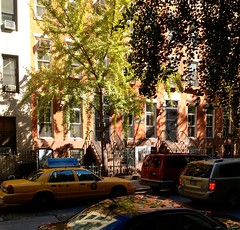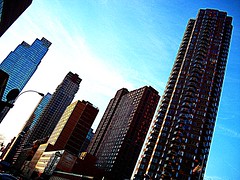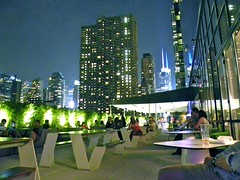Hell's Kitchen, Manhattan
Hell's Kitchen, also known as Clinton, is a neighborhood on the West Side of Midtown Manhattan in New York City. It is considered to be bordered by 34th Street (or 41st Street) to the south, 59th Street to the north, Eighth Avenue to the east, and the Hudson River to the west.
Hell's Kitchen has long been a bastion of poor and working-class Irish Americans, though significant demographic changes have occurred especially from the late 1970s to early 2000s and present. Though its gritty reputation has long held real-estate prices below those of most other areas of Manhattan, even by 1969, the City Planning Commission's Plan for New York City reported that development pressures related to its Midtown location were driving people of modest means from the area.
Since the early 1980s, the area has been gentrifying, and rents have risen rapidly. Home of the Actors Studio training school, and adjacent to Broadway theatres, Hell's Kitchen has long been a home to fledgling and working actors. Today, in addition to the long-established Irish-American and Hispanic-American populations in the neighborhood, the area has a large LGBTQ population and is home to a large number of LGBTQ bars and businesses.
Hell's Kitchen is part of Manhattan Community District 4. It is patrolled by the 10th and Midtown North Precincts of the New York City Police Department. The area provides transport, medical, and warehouse-infrastructure support to the business district of Manhattan. It is also known for its extensive selection of multiethnic, small, and relatively inexpensive restaurants, delicatessens, bodegas, bars, and associated nightlife.
Boundaries
The name "Hell's Kitchen" generally refers to the area between 34th to the south and 59th Street to the north. Starting west of Eighth Avenue and the north side of 43rd Street, city zoning regulations generally limit buildings to six stories. As a result, most of the buildings are older, and are often apartments. For the most part, the neighborhood encompasses the ZIP Codes 10019 and 10036. The post office for 10019 is called Radio City Station, the original name for Rockefeller Center on Sixth Avenue.
The neighborhood overlaps Times Square and the Theater District to the east at Eighth Avenue. On its southeast border, it overlaps the Garment District also on Eighth Avenue. Two landmarks are located here – the New Yorker Hotel at 481 Eighth Avenue, and the Manhattan Center building at the northwest corner of 34th Street and Eighth Avenue. Included in the transition area on Eighth Avenue are the Port Authority Bus Terminal at 42nd Street, the Pride of Midtown fire station (from which an entire shift, 15 firefighters, died at the World Trade Center), several theatres including Studio 54, the original soup stand of Seinfelds "The Soup Nazi"' and the Hearst Tower.
The northern edge of Hell's Kitchen borders the southern edge of the Upper West Side, though the section west of Ninth Avenue and south of 57th Street is also part of the Columbus Circle neighborhood. 57th Street was traditionally the boundary between the Upper West Side and Hell's Kitchen, but another interpretation puts the northern border at 59th Street, where the names of the north–south avenues change. Included between 57th and 59th Streets the Time Warner Center at Columbus Circle; Hudson Hotel; Mount Sinai West, where John Lennon died in 1980 after being shot; and John Jay College.
Beyond the southern boundary is Chelsea. The Hudson Yards neighborhood overlaps with Hell's Kitchen, and the areas are often lumped together as "West Midtown", given their proximity to the Midtown Manhattan business district. The traditional dividing line with Chelsea is 34th Street. The area between the rail corridor at Pennsylvania Station and the West Side Yard and 42nd Street, and east of the Jacob K. Javits Convention Center, is also known as Hell's Kitchen South.
The western border of the neighborhood is the Hudson River at the Hudson River Park and West Side Highway.
Name
Several explanations exist for the original name. An early use of the phrase appears in a comment Davy Crockett made about another notorious Irish slum in Manhattan, Five Points. According to the Irish Cultural Society of the Garden City Area:
According to an article by Kirkley Greenwell, published online by the Hell's Kitchen Neighborhood Association:
Local historian Mary Clark explained the name thus:
The 1929 book Manna-Hatin: The Story of New York states that the Panic of 1857 led to the formation of gangs "in the notorious 'Gas House District' at Twenty-First Street and the East River, or in 'Hell's Kitchen', in the West Thirties."
Hell's Kitchen has become the most frequently used name of the neighborhood, even though real estate developers have offered alternatives of "Clinton" and "Midtown West", or even "the Mid-West". The "Clinton" name, used by the municipality of New York City, originated in 1959 in an attempt to link the area to DeWitt Clinton Park at 52nd and Eleventh Avenue, named after the 19th century New York governor.
History
Early history and development
On the island of Manhattan as it was when Europeans first saw it, the Great Kill formed from three small streams that united near present-day Tenth Avenue and 40th Street, and then wound through the low-lying Reed Valley, renowned for fish and waterfowl, to empty into the Hudson River at a deep bay on the river at the present 42nd Street. The name was retained in a tiny hamlet called Great Kill, which became a center for carriage-making, while the upland to the south and east became known as Longacre, the predecessor of Longacre Square (now Times Square).
One of the large farms of the colonial era in this neighborhood was that of Andreas Hopper and his descendants, extending from today's 48th Street nearly to 59th Street and from the river east to what is now Sixth Avenue. One of the Hopper farmhouses, built in 1752 for John Hopper the younger, stood near 53rd Street and Eleventh Avenue; christened "Rosevale" for its extensive gardens, it was the home of the War of 1812 veteran, Gen. Garrit Hopper Striker, and lasted until 1896, when it was demolished. The site was purchased for the city and naturalistically landscaped by Samuel Parsons Jr. as DeWitt Clinton Park. In 1911, New York Hospital bought a full city block largely of the Hopper property, between 54th and 55th Streets, Eleventh and Twelfth Avenues. Beyond the railroad track, projecting into the river at 54th Street, was Mott's Point, with an 18th-century Mott family house surrounded by gardens, that was inhabited by members of the family until 1884 and survived until 1895.
A lone surviving structure that dates from the time this area was open farmland and suburban villas is a pre-1800s carriage house that once belonged to a villa owned by former Vice President and New York State governor George Clinton, now in a narrow court behind 422 West 46th Street. From 1811 until it was officially de-mapped in 1857, the diminutive Bloomingdale Square was part of the city's intended future; it extended from 53rd to 57th Streets between Eighth and Ninth Avenues. It was eliminated after the establishment of Central Park, and the name shifted to the junction of Broadway, West End Avenue, and 106th Street, now Straus Park. In 1825, the City purchased for $10 clear title to a right-of-way through John Leake Norton's farm, "The Hermitage", to lay out 42nd Street clear to the river. Before long, cattle ferried from Weehawken were being driven along the unpaved route to slaughterhouses on the East Side. Seventy acres of the Leakes' (later the Nortons') property, extending north from 42nd to 46th Street and from Broadway to the river, had been purchased before 1807 by John Jacob Astor and William Cutting, who held it before dividing it into building lots as the district became more suburban.
The West Side later had its own slaughterhouses, which went out of business in the middle 20th century.
Unity with the city and deterioration
There were multiple changes that helped Hell's Kitchen integrate with New York City proper. The first was construction of the Hudson River Railroad, whose initial leg – the to Peekskill – was completed on September 29, 1849, By the end of 1849, it stretched to Poughkeepsie and in 1851 it extended to Albany. The track ran at a steep grade up Eleventh Avenue, as far as 60th Street.
The formerly rural riverfront was industrialized by businesses, such as tanneries, that used the river for shipping products and dumping waste. The neighborhood that would later be known as Hell's Kitchen started forming in the southern part of the 22nd Ward in the mid-19th century. Irish immigrants – mostly refugees from the Great Famine – found work on the docks and railroad along the Hudson River and established shantytowns there.
After the American Civil War, there was an influx of people who moved to New York City. The tenements that were built became overcrowded quickly. Many who lived in this congested, poverty-stricken area turned to gang life. Following Prohibition, implemented in 1919, the district's many warehouses were ideal locations for bootleg distilleries for the rumrunners who controlled illicit liquor. At the start of the 20th century, the neighborhood was controlled by gangs, including the violent Gopher Gang led by One Lung Curran and later by Owney Madden. Early gangs, like the Hell's Kitchen Gang, transformed into organized crime entities, around the same time that Owney Madden became one of the most powerful mobsters in New York. It became known as the "most dangerous area on the American Continent".
By the 1930s, when the McGraw-Hill Building was constructed in Hell's Kitchen, the surrounding area was still largely tenements. After the repeal of Prohibition, many of the organized crime elements moved into other rackets, such as illegal gambling and union shakedowns. The postwar era was characterized by a flourishing waterfront, and longshoreman w…
Hotels Hell's Kitchen, Manhattan
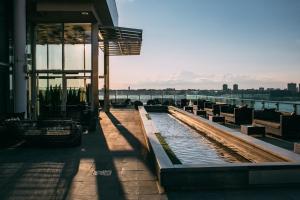 Ink 48 HotelNew York
Ink 48 HotelNew York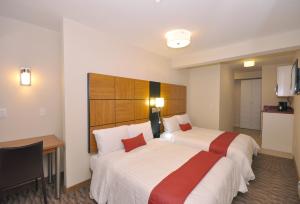 Hotel Five44New York
Hotel Five44New York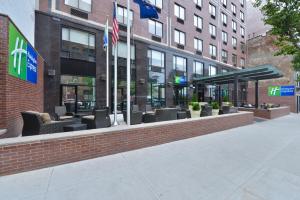 Holiday Inn Express Manhattan Midtown West, an IHG HotelNew York
Holiday Inn Express Manhattan Midtown West, an IHG HotelNew York Comfort Inn Manhattan - Midtown WestNew York
Comfort Inn Manhattan - Midtown WestNew York 454-3W PRIME location 2BR Newly Furnished sleeps 5New York
454-3W PRIME location 2BR Newly Furnished sleeps 5New York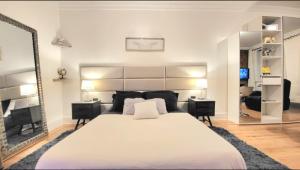 Great Location near Times SquareNew York
Great Location near Times SquareNew York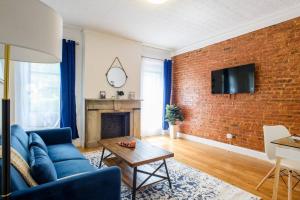 454-4R New 2BR prime midtown Best value Sleeps 5New York
454-4R New 2BR prime midtown Best value Sleeps 5New York Apartment 799: Hells KitchenNew York
Apartment 799: Hells KitchenNew York
Looking for places related to Hell's Kitchen, Manhattan?
Those are other destinations to find places related to Hell's Kitchen, Manhattan:
- Times Square
- USS Intrepid
- Intrepid Sea, Air &…
- USS Growler
- Hell's Kitchen, Man…
- Jacob K. Javits Con…
- Booth
- Bernard B. Jacobs
- New Amsterdam
- Port Authority Bus …
- St. Paul the Apostl…
- Lunt-Fontanne
- Morgan Stanley Buil…
- Candler Building
- Hotel Astor
- Circle in the Square
- Duffy Square
- Shubert
- Gershwin
- Ambassador
- Birdland
- New World Stages
- Chelsea Theater Cen…
- Palace

